
Japanese Collection
The Japanese Collection is the second largest collection department of the Ferenc Hopp Museum of Asiatic Arts. It has been formed for 150 years: it covers hundreds of years, consists of almost eight thousand objects coming from almost two hundred collectors. The majority of the more than seven thousand pieces of art originate from the Edo (1603–1867) and the Meiji (1868–1912) periods. The foundation of the collection was laid by Ferenc Hopp, who, during his travels around the world, stayed in Japan three times for longer periods. He owned a collection of about 1,800 items bought or ordered from there. At the time of his death, half of his collection of four thousand objects consisted of Japanese artefacts. After the establishment of the museum, this department continued to expand via transfer from other private or public collections, bequests, purchases during study tours, and the museum’s conscious acquisitions. Beside Ferenc Hopp, the collection preserves the memory of János Xántus, Count Péter Vay, Attila Szemere, Aurél Gászner, Vince Wartha, Emil Delmár, Ottó Fettick, Nándor Montenuovo, Béla Ágai and his wife, László Passuth, Zoltán Felvinczi Takács and Tibor Horváth through the objects they collected.
The oldest pieces of fine art in the collection are related to Japanese Buddhism. The earliest piece of sculptural art in the collection, a seated figure of Shaka Nyorai from the Heian period (795–1184), carved in wood, was collected by the Catholic bishop, Count Péter Vay when he was visiting missions in Asia. The Kamakura period (1185–1333) is represented by a statue of Amida Buddha, which was purchased in the 1950s. During a visit to Japan in 1907, Count Péter Vay purchased almost 2,500 pieces of art on behalf of the Hungarian state, for the Museum of Fine Arts. For the first time in the history of collecting Japanese art in Hungary, the majority of the collectables were works of fine arts. This collection serves as the basis of the present collection of paintings, sculptures, and graphic art at the Ferenc Hopp Museum. The majority of the 1,500-piece woodblock print collection also comes from Vay’s collectables: they feature the works of the greatest masters of the Torii, Katsukawa, Utamaro, and Utagawa schools. The group of more than two hundred books of woodblock print from the Edo period is also worth mentioning here. Recent acquisitions are shunga prints in the style of Harunobu from the 18th century and a "catfish print" or namazu-e, made after the Ansei earthquake of 1855.
The section of paintings is dominated by the works of the Kanō school, ukiyo-e woodblock prints, pictures of the masters of Nanga painting, and those of the Nihonga movement. One of the oldest paintings in the Japanese collection is Ikei Shūtoku’s Sparrows on bamboo from the sixteenth century. An important masterpiece is Tani Bunchō’s companion piece of his blue and gold landscape, Hirai Baisen’s monumental narrative scrolls depicting the last hours of the Heike clan, as well as Araki Kampo’s Peacock, painted on silk. A special piece in the collection is a painted album illustrating scenes from the fifty-four chapters of Genji Monogatari (Tale of Genji), created in the eighteenth century in the style of the Sumiyoshi school. Hokusai's ink painting on silk representing sweetfish (Ayu) from the artist's last larger creative period, and a unique sketchbook of Kawanabe Kyosai (1831-1889) are valuable recent additions to the collection.
In addition to sculptures, paintings, and woodblock prints, different genres of the more traditional ways of artistic creation can also be found in the Japanese Collection. These are represented by the objects bequeathed to the museum by János Xántus, Ferenc Hopp, Attila Szemere, Vince Wartha, the Ágai couple, and Ottó Fettick. The lacquer collection of almost a thousand items boosts a variety of everyday and ritual objects with different functions, ranging from children’s toys to accessories of armour, some of them exquisitely done, demonstrating a rich diversity of techniques. The five hundred netsukes form an outstanding section, the heterogeneous composition of which allows the museum to present different material types, the most important schools of the netsuke genre, and the breathtakingly high technical quality of such small objects. The Ferenc Hopp Museum’s collection of netsukes, inrōs, and other “hanging objects” numbers over a thousand pieces.
Among the earliest pieces of the Japanese Collection, the pottery fragments of the Jomon period (from ca. 12000 BC to ca. 300 BC) have to be mentioned. The earliest glazed ceramics date back to the thirteenth century, although most pieces originate from the eighteenth and nineteenth centuries. The vessels and tea canisters used in tea ceremonies are worth a particular mention due to their rustic forms and singular glazes, which reflect the aesthetic philosophy of imperfection known as wabi-sabi. The majority of ceramic pieces consist of Arita porcelains, some of which date back to the seventeenth century. Besides, a great number of Kutani porcelains and Satsuma ware, as well as creations of modern artists and schools in Tokyo and Yokohama can be found in the collection.
The life of the samurais is represented by a few pieces of armour, numerous swords and other weapons, and some finely worked sword furnishings. The collection contains relatively few items that were used in battle, and most pieces were made during the peaceful Edo period, especially in its second half.
The costumes, textile samples, and the collection of textile patterns donated to the museum by Madame Mashima Rieko in 2011 represent the refinement of silk weaving techniques, iconographic traditions, and motifs.
The Japanese Collection is constantly growing with modern and contemporary artworks. Important twentieth-century pieces are the fragments of paintings that depict the destruction caused by the atomic bombing of Hiroshima, by Toshi and Iri Maruki, donated to the museum by the artists. The growth of the collection in the 1990s features the works donated to the museum by calligraphy artist Mizutano Goyo. A major acquisition in 2017 is a series of watercolour paintings by George Komor documenting the reconstruction of Yokohama after the earthquake in 1923. The latest additions to the Japanese Collection are Koyanagi Tanekuni’s three contemporary lacquer boxes and a water vessel with a lid (mizusashi), created by Ohi Chozaemon XI (1958–) in 2018. Lately, the museum has also been collecting western art that is created under Japanese inspiration, thus, many objects of applied art with orientalising Japanese characters, as well as contemporary Hungarian jewellery inspired by Japan, and Zoltán Gaál’s photographs taken in Japan are added to the collection.
Gallery

THE EYE TEST
Japan, second half of the 19th century
Ivory okimono
From the collection of Ferenc Hopp
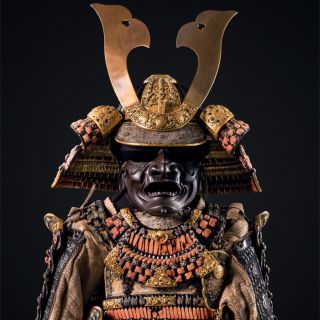
Japan, early 19th century
Dated on the helmet
(in Japanese: kabutō):
“January 1821”
Bronze, iron, textile, leather, lacquer (maki-e), gilding
From the collection of Nándor Montenuovo
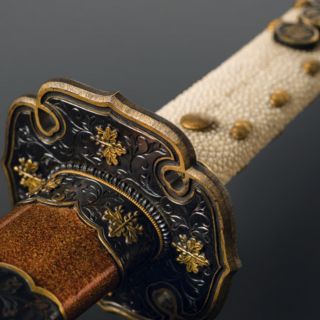
WITH KIRI-MON DECORATION ON THE GOLD-LACQUERED SHEATH
Japan, early 19th century
Steel, iron, copper, stingray leather,
lacquer, leather
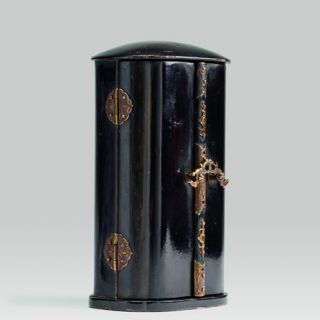
IN THE CENTRE, AND LANDSCAPES WITH FEMALE FIGURES PAINTED
ON THE TWO WINGS (THE FIGURE ON THE RIGHT IS KICHIJŌTEN)
Japan, Edo period, 18th century
Wood, lacquer, gilt and painted, with gilt copper fittings
From the collection of Aurél Gászner
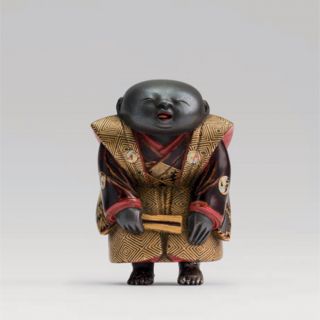
Japan, second half of the 19th century
Wooden netsuke decorated with polychrome lacquer
From the collection of Gyula Bischitz
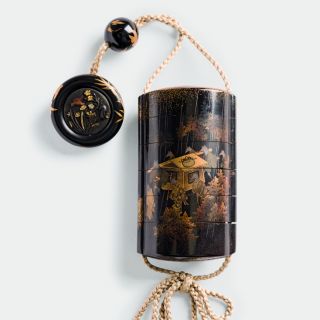
INRŌ WITH FIVE COMPARTMENTS,
WITH “FOX’S WEDDING” MOTIF
(IN JAPANESE: KITSUNE NO YOMEIRI)
Japan, mid-18th century
Wood, lacquer (maki-e), bronze, gold, silver, textile cords
From the collection of Emil Delmár,
and later that of Ottó Fettick

TEA BOWL (IN JAPANESE: CHAWAN), FEATURING SYMBOLS OF HOTEI,
GOD OF HAPPINESS, AND A WAKA (JAPANESE POEM)
Japan, 1833
Earthenware, salmon-red glaze and white paint
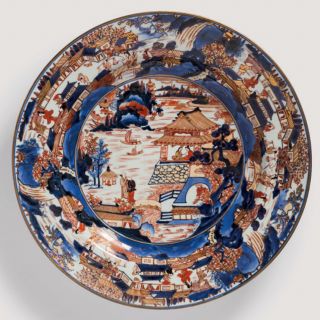
IN ITS CENTRE AND AROUND THE RIM
Japan, Arita (former Hizen province), 1690–1730
Porcelain, blue underglaze painting and red and gold overglaze painting

Japan, Kamakura period, ca. 12th century
Wood, lacquer, gold, rock crystal
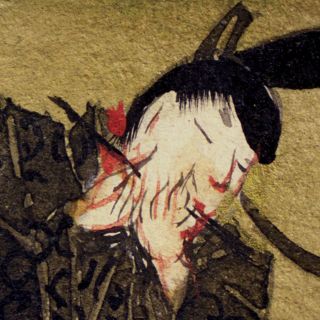
GENJI MONOGATARI ALBUM (detail)
Late 18th century – early 19th century
Gold, ink and colours on paper, with pattern-weave silk fabric cover
Gift from Gyula Tornai, who previously received it as a gift from Ōkuma Shigenobu
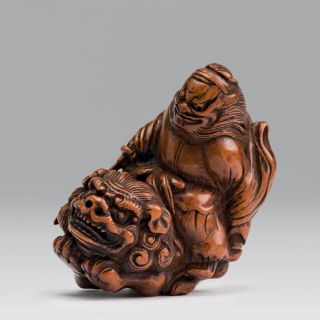
SHŌKI RIDING A LION
Japan, before 1871
Wooden netsuke
From the collection of Ferenc Hopp

BLUE-AND-GOLD LANDSCAPE (detail)
Japan, 1828
Ink, colours and gold on silk, paper, wood
Hanging scroll painting (one of a pair)
(in Japanese: kakemono)
From the collection of Nándor Montenuovo
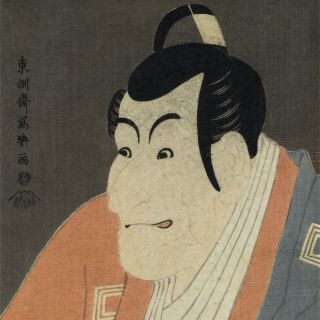
PORTRAIT OF ICHIKAWA EBIZO IV IN THE ROLE OF TAKEMURA SADANOSHIN
Japan, 1794–1795
Colour woodblock print
Collected by Péter Vay
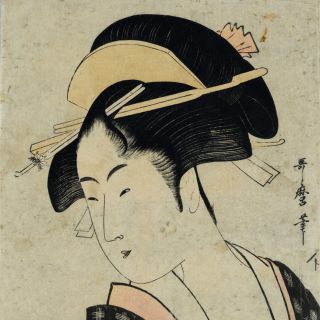
PORTRAIT OF A BEAUTY TYING HER OBI
Japan, ca. 1790
Colour woodblock print
From the estate of Lajos Kozma
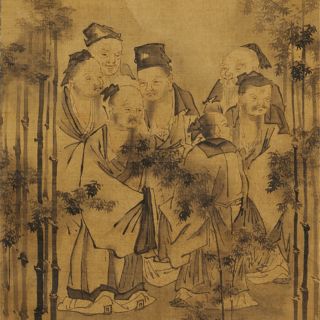
SEVEN SAGES IN A BAMBOO GROVE (detail)
Japan, early 18th century
Ink on silk, paper, wood
Hanging scroll painting (in Japanese: kakemono)
Collected by Péter Vay